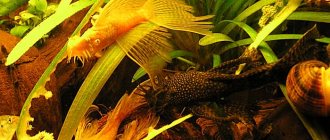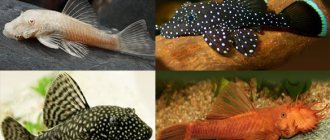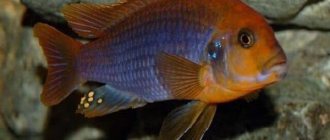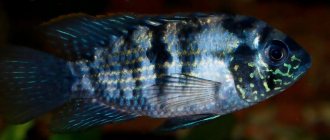The red catfish Ancistrus is an ornamental aquarium fish that is distinguished by its beautiful appearance. Ancistrus vulgaris are characterized by a black-brown body color with small spots. Their homeland is freshwater reservoirs of South America (Orinoco and Amazon rivers) and mountain rivers. The body of all ancistrus is flattened, teardrop-shaped, covered with polygonal bony plates, and only star-shaped catfishes have an abdomen without such plates. Pelvic and pectoral fins are paired. The adipose and anal fin are small, the dorsal fin is large and vertical.
Species of ornamental ancistrus also have a rounded mouth with elongated lips and horn-like suckers. The oral suckers have “graters,” or horny tubercles, with which the fish scrapes off fouling from plants, snags, stones, and glass. Males are distinguished by bushy leathery growths on their heads; females either do not have such growths, or they are weakly expressed.
Appearance
The red-tailed catfish is one of the largest aquarium fish. Appearance:
- The body shape is oblong.
- The head is massive, the eyes are large and protruding.
- Mustaches - 3 pairs: the 1st is located on top of the jaw, the other 2 pairs are on the lower jaw.
- The caudal fin is red with orange tints.
- Color – the back is gray with spots of small diameter. The belly is painted white with yellowish tints.
There are no sexual differences between females and males.
Ancistrus: types and description
Russian-language name of the fish: sticky catfish, ancistrus, cleaner catfish, sucker catfish.
Order, family: carp-shaped, chain-mailed or locariform catfishes (Cypriniformes, Siluroidei, Loricariidae).
Suitable water temperature: 20-28 °C.
“Acidity” Ph: 6-7.5.
Hardness dH: up to 20.
At home, the fish grows up to 15 cm. Please note that males are slightly smaller than females. In addition, adult male catfish have mustaches up to 2 cm in size. The head and front part of the body of aquarium fish are flattened. There are plate-like bone growths on the sides. There is a high fin on the back, small fins are located on the chest and near the abdomen.
Ancistrus has a rounded mouth, and suckers are visible on its lips. Thanks to its unusual mouth, the fish looks awkward and funny. With suction cups, the catfish can hold on to rocks in a fast river, and also scrapes algae from snags, stones and plants.
Photo: albino
Content Features
Raising redtail catfish in an aquarium is no easy task. Only experienced aquarists can cope with it, since for fractocephalus it will be necessary to create specific conditions:
- The volume of the artificial reservoir is at least 7500 liters.
- Parameters : temperature – from +21°С to +26°С, acidity – from 5.5 to 7.2, hardness – from 3 to 13.
- The current is weak.
- Filtration and aeration . Installation of a powerful filter and aerator is required, since catfish do not tolerate pollution.
- Water changes are daily. But subject to careful hygiene, it is allowed to replace it 2 times during the week.
- Decoration requires the presence of a large number of shelters: grottoes and snags, boulders.
- Lighting is moderate. Catfish do not tolerate excessively bright and intense lighting.
- The soil is sandy, fish love to bury themselves in the sand. It is not recommended to fill the bottom with gravel, as catfish can swallow small stones, which will damage their gills.
- Plants - with a powerful root system and hard leaves.
Important. Do not overload the aquarium with decorations. Given the large dimensions, the fish needs sufficient space to move around the tank.
Features of feeding
The red-tailed catfish is an absolute predator, and this is what should be taken into account when choosing a diet. Feeding rules:
- Fish are prone to obesity. Feeding is carried out once a day for growing catfish. An adult can be fed only once a week.
- Favorite food is insects. Catfish will happily feast on fruits that have been pre-cut into small pieces.
- The diet should include live food. The ideal option would be: earthworms, mussels and shrimp, frogs, white fish (fillets).
- It is also recommended to give industrial feed, which contains vitamins and minerals.
- It is strictly forbidden to feed catfish with liver and fresh meat. These products will cause disturbances in the functioning of the digestive system, even death.
The red-tailed catfish quickly gets used to one food, which is why over time it may refuse it. Therefore, the menu should be varied.
Common catfish (Moscow region)
Common catfish (Moscow region) Silurus glanis Linnaeus, 1758 Class Bony Fishes - Osteichthyes Order Catfishes - Siluriformes Family Catfishes - Siluridae
Status. 1st category. Originally a rare species for the region, it is now endangered.
Spreading.
Basins of the Baltic, Black, Caspian and Aral seas. In the Moscow region it is found in the river. Oka, lower and middle reaches of the river. Moscow, r. Klyazma (on the border with the Vladimir region), in the Ivankovsky reservoirs and the canal system named after. Moscow, in the lower reaches of the river. Sister (1-3). In the r. In Moscow, above the capital, the only recorded case of catching catfish in recent decades was in the late 1970s. (4).
Number and trends of its change
It has always been a rare species in the Moscow region (5). Currently, due to a decline in numbers, it has become very rare in most water bodies (6, 7).
Features of biology and ecology
It can reach a length of up to 5 m and a weight of up to 300 kg, but currently individuals over 10 kg are rare. Ripens at the age of 4-5 years. The eggs are laid in a primitive nest; After spawning, the male guards the clutch. Leads a sedentary lifestyle, making minor migrations during the spawning period. In winter it lies in pits and does not feed. Lives up to 30-40 years.
Limiting factors
Due to its large size and tasty meat, it is an attractive fishery target and is intensively caught. Its settled nature and confinement to deep places (holes) allow fishermen to easily determine its location and thereby facilitate catching.
Security measures taken
Listed in the Red Books of the city of Moscow (2001), Tver (2002) and Ryazan (2001) regions (9-11). Before inclusion in the Red Book of the Moscow Region (1998), fishing rules for catfish were limited (no more than 1 individual per fisherman per day) (8). In 2003, the Government of the Moscow Region approved rates for calculating the amount of recovery for damage caused by illegal fishing or harvesting of fish species listed in the Red Book of the Moscow Region.
Recommendations for preserving the species in natural conditions.
Strict control over compliance with the fishing ban, identification and protection of spawning grounds, intensification of educational work among amateur fishermen about the inadmissibility of catching catfish.
Recommended and cited literature
It is advisable to create a broodstock and organize artificial reproduction.
Recommended and cited literature
Red Book of the Moscow Region 1. Reservoirs..., 1969; 2. Sokolov et al., 1994; 3. Sabaneev, 1982b; 4. A.V. Rusanov, personal. message; 5. Chernushenko, 2000; 6. Shatunovsky et al., 1988; 7. Tsepkin, Sokolov, 1987; 8. Rules of amateur..., 1984, 9. Red Book of the City of Moscow, 2001; 10. Red Book of the Tver Region, 2002; 11. Red Book of the Ryazan Region, 2001. Compiled. N.I. Shilin.
1. common catfish Red Book of Moscow
AOF | 02/14/2016 07:32:03
Back forward
Character and behavior
Red-tailed catfish are quite specific aquarium inhabitants with unusual habits:
- They are nocturnal, and prefer to spend daylight hours buried in the ground or hiding in a shelter.
- The character, despite the terrifying appearance, is quite calm and peaceful. Fish can be aggressive if someone decides to encroach on their territory. In this regard, it is not recommended to keep several adult individuals in one aquarium.
- They recognize the owner. When it appears near the aquarium, they will swim up to the glass, begging for food. They can take food directly from your hands.
- They make sounds similar to roars. A similar phenomenon occurs due to the expulsion of a mixture of air and water through closed gills.
Feeding the fry of catfish - red ancistrus suckers - in an aquarium
Ancistrus red
Photo: red ancistrus, in an aquarium on the ground.
Red ancistrus fry are fed with crushed plant food, gradually introducing live protein feed into their diet. The best place to start is with spirulina tablets.
Then add plant food. In addition to small plant foods, you can give the heart of a cucumber, cut into flat slices, boiled cabbage, lettuce, raw potatoes and other plant foods.
You definitely need driftwood as a source of cellulose. Water must be changed every day, adding from the aquarium. Although it is believed that red ancistrus fry breathe air, aeration of the water is still necessary.
Breeding and Spawning
Reproduction of red-tailed catfish in an aquarium is almost impossible. To date, such spawning data are not available. Difficulties in breeding are primarily due to the fact that there are no sexual differences in individuals. Therefore, even an experienced aquarist will not be able to choose a pair. In addition, spawning requires a tank of non-standard, huge sizes. It is physically impossible to keep such aquariums in residential premises.
Possible diseases
Red-tailed catfish are characterized by excellent, good health. The only thing he can get sick with is obesity, which develops as a result of poor nutrition and frequent feeding. This is a real problem for catfish, often leading to their death.
Due to poor nutrition, especially if the diet includes fresh meat or offal, dangerous digestive problems can occur. If the disease is not recognized in a timely manner, it will lead to dysfunction of all internal organs, and it will not be possible to save the catfish.
Is it worth getting a red-tailed catfish?
It is extremely rare to find this fish in home aquariums, since fractocephalus reaches enormous sizes and needs a reservoir of at least 7.5 tons of water, which is almost impossible to organize at home. Despite the fact that catfish will feel comfortable with neighbors of the same size, it is not possible to find similar fish, much less keep them.
Don’t be fooled by the “modest” size of young individuals. Fractocephalus grows very quickly. In just a few months they will grow to incredible sizes. Most often, red-tailed catfish are bred as a food product. Their meat is considered an exquisite delicacy.
The life cycle of catfish is about 20 years. If you still want to have such an unusual pet in an aquarium, you need to be prepared for great difficulties. A cramped aquarium and poor quality food are death for red-tailed catfish.
Reproduction
Breeding Ancistrus super red is not difficult. To do this, you will need a spacious aquarium with soft water. In a spawning aquarium, the water must be saturated with oxygen. Red catfish are bred in the same way as other types of ancistrus. A pair of fish or a group of 3-4 spawners, in which there is one male, is planted for spawning. The best spawning substrate is plastic or ceramic pipes. To obtain high-quality offspring, it is important to have purebred sires.
Red ancistrus fry are fed with crushed plant food, gradually introducing live protein feed into their diet. The best place to start is with spirulina tablets.
Then add plant food. In addition to small plant foods, you can give cucumber, cut into flat slices, boiled cabbage, lettuce, raw potatoes, pumpkin and other plant foods.
You definitely need driftwood as a source of cellulose. Water must be changed every day, adding from the aquarium. Although it is believed that red ancistrus fry breathe air, aeration of the water is still necessary.











